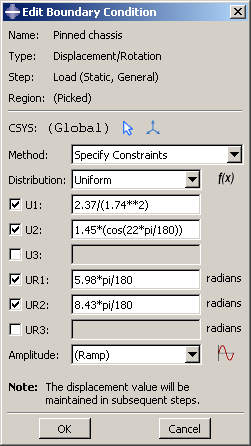Entering expressions | ||
| ||

The expression is evaluated by the Python interpreter that is built into
Abaqus/CAE.
The arithmetic expression is replaced by its value; if you reopen a dialog that
contained expressions, only the values are available. Variables like
pi and functions like
sin() are available because
Abaqus/CAE
imports the Python math module when you start a session. As a result, you can
enter any expression that can be evaluated by Python's built-in functions or by
the Python math module. For more information, see the documentation for
built-in functions and the math module accessible from the official Python home
page (http://www.python.org).
To make sure that your expression is evaluated as expected, you should be aware of the following:
-
If you enter numbers as integers, Python will perform integer division and round down any remainder. For example, Python will interpret
3/2as1and1/2as0. In contrast, Python interprets3./2as1.5and1/2.as0.5. -
Python interprets numbers with leading zeros as octal numbers (for example,
0123is interpreted as83.0). However, Abaqus/CAE will ignore leading zeros in numbers in text fields before Python interprets them; such numbers are evaluated as decimals. -
Python interprets
eas the base of the natural logarithm; that is,eequates to2.71828182846ande+2equates to4.71828182846. -
If the e character is preceded by a number, Python interprets it as an exponent, not a natural logarithm. For example, Python interprets
2e+2as 2 × 102 and equates it to200. -
Python interprets
2e+as 2 × 100 and equates it to2. Similarly, Python interprets2e++11as 2 × 100+ 11and equates it to13.
If you are unsure how Python will interpret your expression, you can enter
the expression on the command line;
Abaqus/CAE
will print the resulting interpreted value in the message area. To access the
command line interface, click
 in the bottom left corner of the main window. For more information,
see
Components of the main window.
in the bottom left corner of the main window. For more information,
see
Components of the main window.
You can also test how
Abaqus/CAE
interprets an expression by entering abaqus
python at an operating system prompt and entering the
expression at the Python prompt that appears. The prompt line and some dialog
boxes do not allow you to enter an expression. As an alternative, you can enter
the expression on the command line or at the Python prompt and paste the
resulting value in the prompt line or dialog box.